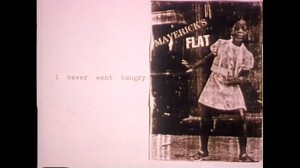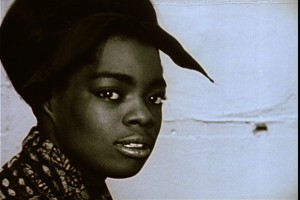Eye on a Director: Canyon Cinema
Canyon Cinema was the subject of a multi-screening program in July and August 2016 at the New York City Museum of Arts and Design, as part of their Eye on A Director series. Working directly with MAD, Canyon’s staff and board of directors served as co-curators for this series, selecting films that reveal the history of an artistic community and its lineage today and focusing on experimental documentaries from Canyon Cinema’s archive that parallel American cinematic movements.
Eye on a Director: Canyon Cinema is co-curated by Antonella Bonfanti, Rebecca Meyers, Seth Mitter, Michael Renov and Jeffrey Skoller of Canyon Cinema, in conjunction with Katerina Llanes, Manager of Public Programs, and Carson Parish, Audio-Visual Coordinator, of the Museum of Arts and Design. Special thanks to Max Goldberg and Scott MacDonald.
Presenting Partners: Anthology Film Archives, The Film-Makers’ Cooperative, Millennium Film Journal
1) Through the Looking Glass: Menken, Kobland, Huot, Palazzolo & Kreines
78 min, 16mm Projection (original program date : July 7th, 2016 )
Avant-garde cinema in America was born just after World War II, and an early subject for many experimental filmmakers was the changing American landscape. Under the influence of Maya Deren, Marie Menken’s “Glimpse of the Garden” is an early instance of non-narrative filmmaking within the movement. A sensuous Ektachrome tour through a colorful landscape, the film elevates still life into a choreographed gesture. Robert Huot’s “Snow” depicts a landscape completely different from Menken’s: a field of falling snow as it transforms, depicted through three different sectors of the images edited with varying density and speed. The program’s centerpiece is Ken Kobland’s “Landscape and Desire,” which the director calls a “mordantly nostalgic” road trip across the United States that offers a vision of a country without the people who populate it. The program ends with a change of pace in Tom Palazzolo and Jeff Kreines’ “Ricky and Rocky,” which eavesdrops on a wedding reception in an Italian family’s backyard in Chicago. Where Kobland creates a landscape void of people, Palazzolo and Kreines re-populate it with a cast of eccentric family members.
Glimpse of the Garden, Marie Menken, 1957, 8 min, (sound)
Snow, Robert Huot, 1971, 3 min (silent)
Landscape and Desire, Ken Kobland, 1981, 55 min (sound)
Ricky & Rocky, Tom Palazzolo & Jeff Kreines, 1972, 15 min (sound)
2) Five Artists: Billbobbillbillbob
70 min, 16mm Projection (original program date : July 14th, 2016)
Five Artists is a loving portrait of quintessential California artists: The painters, sculptors and filmmakers William Allen, William Geis, Robert Hudson, Robert Nelson and William T. Wiley. A collaboration between two of Canyon Cinema’s earliest members, Gunvor Nelson and Dorothy Wiley, the film takes a personal look at the lives of these close friends: at home with their families, at work in the studio, teaching, fishing, drawing together, at parties, openings and elsewhere. Alternating between color and black-and-white footage, Nelson and Wiley use non-synchronous comments and music by the artists mixed with impressions by friends and acquaintances—creating a delicate collage of the complexities of everyday life, family relationships and the circle to which they all belonged. One of five works co-authored by Gunvor Nelson and Dorothy Wiley, Five Artists reflects the communal spirit that has become synonymous with the early days of Canyon Cinema.
Five Artists: Billbobbillbillbob, Gunvor Nelson, 1971, 70 min (sound)
3) Sense and Sensuality: Bay Area Feminist Filmmaking of the 1980s
Curated by Jeffrey Skoller – 83 min, 16mm Projection (original program date : July 21st, 2016)
Much critical attention to women’s avant-garde filmmaking of the 1970s and 1980s focused on East coast and European feminist filmmakers, the critique of visual pleasure and the notion of the male gaze in cinema. In San Francisco, a new generation of feminist avant-garde filmmakers were emerging with a very different approach to questions of gender and pleasure in cinema. Influenced as much by the work of Gunvor Nelson and Chick Strand as by Laura Mulvey and Yvonne Rainer, these artists emphasized visual pleasure, finding in cinema sensual and lyrical ways to explore the personal and political experience of coming to consciousness as young radicals. Their focus on color, texture, montage, sounds and text created a deeply sensuous and searching cinema. This largely unheralded body of work housed at Canyon has influenced subsequent feminist filmmaking on the West Coast and beyond.
Valley Fever, Stephanie Beroes, 1979, 20 min (sound)
Maternal Filigree, Sandra Davis, 1980, 18 min (silent)
Sincerely, Lynn Marie Kirby, 1980, 14 min (sound)
Department of the Interior, Nina Fonoroff, 1986, 9 min (sound)
Futility, Greta Snider, 1989, 9 min (sound)
Chronicles of a Lying Spirit (by Kelly Gabron), Cauleen Smith, 1990, 13 min (sound)
4) Panel led by Scott MacDonald with Dominic Angerame, Jonas Mekas, Seth Mitter, and Lynne Sachs
(original program date : July 28th, 2016)
Scott MacDonald is author of the series A Critical Cinema: Interviews with Independent Filmmakers (University of California Press, 1988–2006) and eleven other books including The Garden in the Machine: A Field Guide to Independent Films about Place(California, 2001), Canyon Cinema: the Life and Times (California, 2008), and most recently Avant-Doc: Intersections of Documentary and Avant-Garde Cinema (Oxford, 2014) and Binghamton Babylon: Voices from the Cinema Department (a nonfiction novel) (SUNY Press, 2015). He was named an Academy Scholar by the Academy of Motion Picture Arts and Sciences in 2012. He is a Professor of Film History at Hamilton College.
Dominic Angerame is a filmmaker and educator who served as Executive Director of Canyon Cinema from 1980–2012. He teaches filmmaking and cinema studies at colleges and universities in the San Francisco Bay Area.
Jonas Mekas is a Lithuanian-American filmmaker, poet and artist. He is the founder ofFilm Culture magazine and Anthology Film Archives, and the author of more than twenty books and the maker of hundreds of films across six decades. Mekas co-founded the Film-Makers’ Cooperative in 1962, providing the model and inspiration for the creation of Canyon Cinema in 1967.
Seth Mitter joined Canyon Cinema as Collection Manager in 2015. He is a trained audiovisual archivist and projectionist. He studied filmmaking at The New School in New York.
Lynne Sachs is a maker of film essays, experimental documentaries and live film performances, and has been a Canyon Cinema filmmaker for over twenty years. She teaches experimental film and video at Princeton University and lives in Brooklyn.
5) Peter Hutton: July ’71 + Skagafjörður (Q&A with Michael Renov)
Curated by Michael Renov and Antonella Bonfanti
99 min, 16mm Projection (original program date : August 4th, 2016)
Peter Hutton has produced a remarkable filmic oeuvre over nearly half a century. Starting out as a sculptor, painter and photographer, he studied at the San Francisco Art Institute in the late 1960s where he was influenced by Bruce Baillie, Bruce Conner, Bruce Nauman and Robert Nelson. Writing in ArtForum on the occasion of Hutton’s 2008 MoMA retrospective, the critic P. Adams Sitney characterizes the director’s work thus: “…subtle fluctuations in the visible field—of light, or figures and objects in motion, or slight camera movements—configure the ecstatic concentration of the filmmaker’s attention.”
Skagafjörður (2002–2004), commissioned by the Icelandic Film Centre with additional funding from the Whitney Museum of American Art, is a film “of sumptuous beauty, with barely a vestige of human presence,” according to Sitney. It immerses the viewer in the Icelandic landscapes, with careful attention given to the scale and contours of the land, sea, quality of light and the blending of visible textures and tonalities at the horizon line where sky and cloud meet sea and land.
By contrast, July ’71 in San Francisco, Living at Beach Street, Working at Canyon Cinema, Swimming in the Valley of the Moon (1971), is a diaristic film that affectionately captures the people and places Hutton encountered while living in the Bay Area. Filmmaker David Bienstock describes it as “one of the best of the genre—for it truly lets us get inside the filmmaker’s mind and sensations through, and in conjunction with, his role as filmmaker. It is almost as if we see how carrying around the camera and focusing on different people, things and events actually changes and refines the filmmaker’s normal perception of them. The camera becomes an instrument not to record reality but to expand it. And like any diary, it is both an exploration and crystallization of events and impressions in one’s life.”
July ’71 in San Francisco, Living at Beach Street, Working at Canyon Cinema, Swimming in the Valley of the Moon, Peter Hutton, 1971, 35 min (silent)
New York Portrait, Chapter II, Peter Hutton, 1981, 16 min (silent)
Landscape (For Manon), Peter Hutton, 1987, 18 min (silent)
Skagafjörður, Peter Hutton, 2002–2004, 33 min (silent)
6) Secession: The Decay of Patriarchy
71 min, 16mm Projection (original program date : August 11th, 2016)
Highlighting multiple generations of feminist filmmakers across the country, Canyon’s archive is an encompassing survey of radical cinema. With Take Off, Gunvor Nelson introduces the viewer to Burlesque legend Ellion Ness, using the camera and editing effects to make a statement about what it means to strip as a woman. JoAnn Elam’s “Lie Back and Enjoy It” is an eight-minute dialogue about rape culture and the representation of women living under patriarchy. It consists of optically printed images set to a structural conversation on the very film the viewer is watching. Abigail Child’s “Mutiny” interprets and interpolates the voices and music of a diverse cast of women. In “The Color of Love,” Peggy Ahwesh uses a variety of chemical reactions to alter and recompose images taken from a pornographic film. In “Menses,” Barbara Hammer elevates the imagery and politics of menstruation with high drama and wry wit. The program closes with “Generations,” a collaborative film by Hammer and Gina Carducci, who uses a Bolex camera to shoot the final days of the Astroland ride in a downtrodden Coney Island at the turn of the century. Hammer and Carducci edited their own halves of the film and joined the two in the middle.
Take Off, Gunvor Nelson, 1972, 8 min (sound)
Lie Back and Enjoy It, JoAnn Elam, 1982, 8 min (sound)
Mutiny, Abigail Child, 1983, 11 min, (sound)
The Color of Love, Peggy Ahwesh, 1994, 10 min (sound)
Menses, Barbara Hammer, 1974, 4 min (sound)
Generations, Gina Carducci & Barbara Hammer, 2011, 30 min (sound)
7) Continuing Cadences: Fulton, Angerame, Sonbert
Curated and introduced by Rebecca Meyers
80 min, 16mm Projection (original program date : August 18th, 2016)
Robert Fulton (1939–2002) was a pilot, a gifted aerial cinematographer, a devout Buddhist, a close friend and collaborator of filmmaker Robert Gardner, and an inspired independent filmmaker. His exhilarating, densely edited, poetically sensitive films were admired by Canyon stalwarts Bruce Baillie and Stan Brakhage, and he was an inspiration for students including filmmaker and former Canyon Cinema Executive Director Dominic Angerame. An artist who traveled the world accompanied by his Bolex camera, he eschewed narrative as he gathered images with a spirit of wonder and generosity, translating the people and places he encountered into scenes of breathtaking beauty and elation, and editing with a dazzling rhythm whose cadences evoke a deep passion for and knowledge of music. Fulton left behind a substantial body of work that resonates with Warren Sonbert’s exuberant and visually resplendent montage.
Path of Cessation, Robert E. Fulton, 1974, 15 min (sound)
Continuum, Dominic Angerame, 1987, 14 min (silent)
Swimming Stone, Robert E. Fulton, 1982, 14 min (sound)
Short Fuse, Warren Sonbert, 1992, 37 min (sound)









